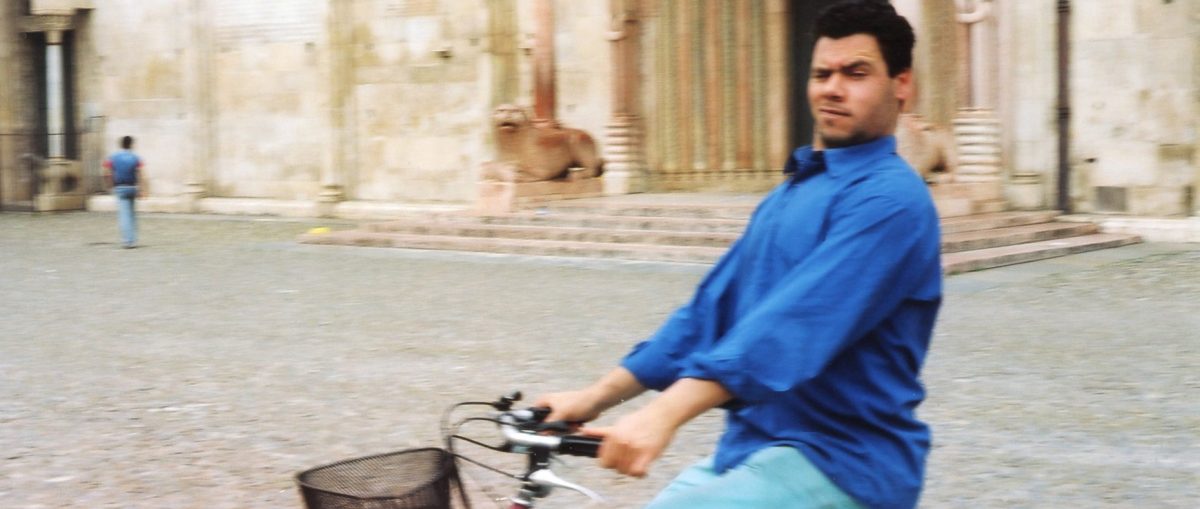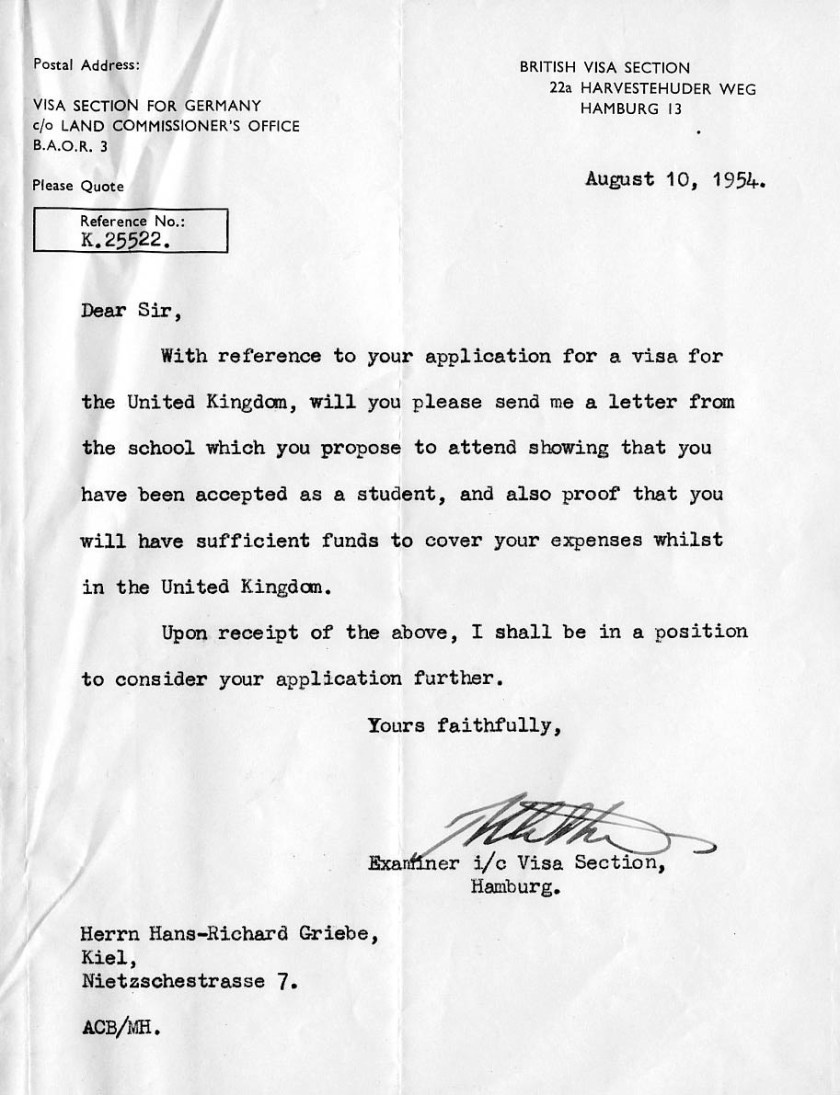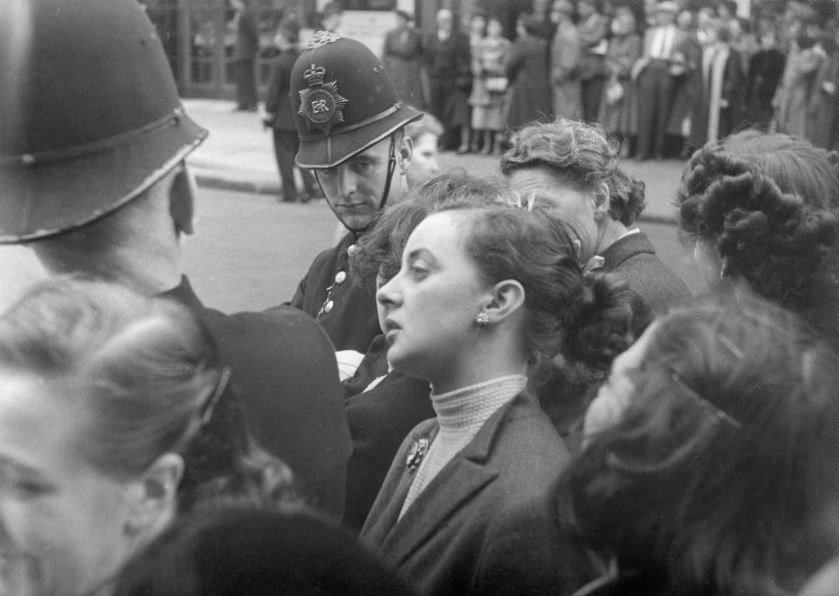March 2014: Additional photos from Shadwell, East London added, and identified. Scroll two thirds of the way down – Le Patron.
London Town ’54 A large scrapbook of photos bought on ebay, with line drawings and ephemera
Trafalgar Square, September, 1954
London Town 54, the complete book of photos is now online. londontown54.com
The ebay auction details, from the German seller, followed by a brief selection with a commentary

Hans-Richard Griebe of Kiel went to London in September 1954 to take part in a short course of ‘Colloquial English’ run by the The London School of English in Oxford Street.
He brought with him a 35 mm Exakta camera with a standard and a telephoto lens, and a medium format Rollei.
From the album we can see he is a very good illustrator, but it is his photography that is outstanding.
His album which he called Camera Abroad is an extraordinary record of a London emerging from the rigours of the 1940’s, travelling on its way towards Harold MacMillan’s ‘You’ve Never Had it so Good’. It also upsets notions of grey, wet foggy London Town of the early 1950’s. This is a mostly vibrant, stylish city, with the Festival of Britain only a few years old, and many of its features on the South Bank intact.
We have at the moment no idea what his occupation was, or how he financed his eight weeks in London. His interest in battleships and boats, and coming from Kiel, suggests the possibility he had been in the Third Reich navy.
As with all great photographers he had the ‘eye’ – yes, for women, but also the ambience of London, and its people. Hans-Richard’s delight in London’s women captures the wonderful styles of clothing that were around that Indian summer. Although some of the sequences of women might seem disturbing – basically he was following them along busy streets – he had no difficulty in asking them if he could photograph them. He spotted Wendy when he went on a day trip down the Thames by boat to Southend.
And then he asked to photograph her, and took over ten photos of her.
He used his Rollei often to photograph himself, on, for instance, Westminister Bridge. He’d put it on the pavement with a mechanical timer screwed into the cable release socket. Anyone who has done this will know how difficult it is to position yourself just right. Hans-Richard always got it right.

Using the Exacta with a telephoto lens he got a head and shoulders picture on September 15 of Queen Elisabeth and the visiting Emperor Haile Selassie that is the equal of any Fleet Street shot.
Like most keen photographers of his generation he developed and printed his own negatives (his negative thumb print – bottom right – is visible on one of the many photographs he took in Southend).
‘Wir bleiben in Southend’ is his photo essay spread over 14 pages featuring 45 photos and line drawings by him of what was East London’s pleasure ground. The model of the Royal Hynd, the mile long pier and it’s train, Madame Rene, clairvoyant, the crowded sea front and beach, dripping ice cream cones and a placard protest against German rearmament, juxtaposed with a gent holding a placard demanding Rearmament of the Soul are some of the subjects. There is also a photo spread of Wendy, who posed for him in her shorts and blouse, and then shed those for bathing costume shots.
Hans-Richard travelled down to Southend on the crowded Royal Sovereign, embarking at Tower Bridge. The photo essay on this section of the outing runs to 31 photos.
‘Pflasterkunstler und Sanwichmen’ Four photos on the page, none captioned. ‘Pall Mall East’ sign, top left. This is at the bottom of Pall Mall. This is a typical example of Hans-Richard grabbing the moment perfectly. Another second and the downcast man with cigarette would have walked across the outlines of the people looking at the pavement artist (Pflasterkunstler). He knew exactly when to press the shutter.
‘Rush Hour. In German Rasch nach hause!’ There are three photos on the page with a nice little drawing, in his own hand, of a clock dead on 5 p.m. To take this shot he would have been walking directly behind them, trying to keep them in focus and, as he’s shooting into the light, at the same time metering for the shade. Bert Hardy in his My Life, London, 1985, says that this backlighting technique was one of his own favourites.
 Hans-Richard took several photos of Indians and West Indians, a novelty for a visiting German from Kiel. He also befriended Indian seamen at the Pool of London, and the album contains several portraits of Indian seamen and the pasted in address in India of one of them.
Hans-Richard took several photos of Indians and West Indians, a novelty for a visiting German from Kiel. He also befriended Indian seamen at the Pool of London, and the album contains several portraits of Indian seamen and the pasted in address in India of one of them.
Probably Oxford Street. Selling ladies purses out of a suitcase. His ‘look-out’ is momentarily distracted.
 Probably Oxford Street. Eve eats the apple
Probably Oxford Street. Eve eats the apple
The Shadwell Photos

‘London Docks und East End’ 14 photos spread over 4 pages. They mostly concentrate on the streets, rather than the docks. (He has a separate extensive photo essays on the Pool of London and its ocean going ships). One striking photo, above, is of a street market on a dull dark afternoon, with a barrow of oranges piled up pyramid style foreground, folk in the street and in the distance a railway engine pulling a passenger carriage over the elevated bridge. There is something about it that reminds Le Patron of Andre Kertesz’s Meudon, Paris, 1928. Hans-Richard identifies the five photos on the page as Limehouse. However, since this article was posted online in September, 2013 Le Patron was contacted by Christopher Matheson in February, 2014, who grew up near the above street. He contacted Le Patron using the Leave a Reply facility at the bottom of every online article. (Scroll right down to the bottom to see the original correspondence.)
Christopher identified the street as Watney Street, in Shadwell, not Limehouse. Le Patron sent Christopher more photos from “London Docks und East End” and he has kindly identified where they are. He no longer lives in Shadwell, but still has family there. He has lived in California for many years. Le Patron has now added (March, 2014) several of these streets and places identified by Christopher, and Le Patron thanks him very much.
The railway bridge in the photo above now carries the Docklands Light Railway.


The grim warehouse, the deserted street and the two children at the pub corner reminds Le Patron of a very similar photograph Bert Hardy took in Thomas More Street for Picture Post in the Pool of London story, Picture Post, 3 December, 1949.





End of the Shadwell photos sequence
Interior, Lyons Corner House. Hans-Richard attended the Colloquial English course at the London School of English seen through the window. He captioned the photo ‘Lyons. Im hintergrund School Entrance’. His focus on the stylish woman, of course, makes the picture.
‘Piccadilly Circus’. 18 photos spread over 4 pages, featuring Piccadilly Circus night and day. In this shot white walled tyres on the Ford Zodiac in background, and WPC’s. (Thanks to viewer Paul Gatty spotting that it was a Zodiac, and not a Consul, as I had originally described it. Paul wrote “It is a Ford Zodiac, newly introduced, and top of the range. Very glitzy with the two tone paint as standard, as are the whitewalls.”
‘Hanover Square. Lunchtime’. Five photos on the page. This is the only one captioned: ‘Auf dem schild rechts steht: Resen nicht betreten!’ (The sign on the right says: Please keep off the grass!)
The photo essay on the State visit of Emperor Haile Sellasie is headlined ‘The Last Day but Two’. There are 28 photos. This photo is from the page with the caption ‘The Crowds’.
“Tower” (Tower of London). 19 photos spread over four pages plus line drawings by Hans-Richard. Some photos are captioned. This one isn’t. The pleasures, the pleasures… of smoking. And look at the cuffs on their coats. Wonderful.
In one or two of the prints there is a slight double exposure at the edge, suggesting a slippage with the wind-on mechanism, plus some photographs are soft, suggesting a problem with the standard lens. The repair bill was equal to about a third of a manual workers weekly wage.
And then it was time to go home to Kiel. He left from Victoria railway station, catching the Ostend train.
Again, this photo shows his photo journalist talent. To get the shot of the train he is departing on, he has walked down an adjoining platform at Victoria. Above the couple someone is trying either to slide open the compartment window, or close it.
The complete set of photos from London Town ’54 is now online at londontown54.com It concludes a loose trilogy of online books by Pete Grafton that look at life in Britain from the 1930s through to the mid 1950s.
You, You & You: The People Out of Step with World War Two (2013) covers the 1930s and the Second World War, and Len: Our Ownest Darling Girl (2014) is the immediate aftermath of the war and life in Britain up until 1950.
___________________






























Hi, I am Kevin Clarke, writing from Mount Martha, Victoria, Australia. In the picture of Watney Street, identified by Christopher Matheson, I am the boy wearing the over-sized jeans, next to the couple with the pram. Those jeans were my first pair if long trousers. I was very taken with them — but did not like having to turn up the bottoms. I was aged 9 or maybe just turned 10 when this photo was taken. I lived at 145 Shadwell Gardens, top end of Watney Street, near Shadwell Station. I am now 70 :).
Thanks, Mike – great to hear from you, and incredible you’re pretty sure that is your Mum and Dad by the stall in Witney Street. I’m pretty close to having the complete ‘London Town 54’ online, approx. early March 2016 hopefully. All the best, Pete.
Just seen the photo of Witney street market and the two people standing behind the, stall look like my mum & dad we lived in the pub at the bottom of Witney street called the old house at home, their names were. Rose & Bart Quinn they had three daughters & one son me
Correction of typo on previous posting:
Very interesting throughout.
When Hans Richard took the picture of the cinema showing the film “Rear Window”, he was probably aware that the film features an Exakta 35mm camera that played an important role in the plot!
Very interesting throughout.
When Hans Richard took the picture of the cinema showing the film “Rear Window”, he was probably away that the film features an Exakta 35mm camera that played an important role in the plot!
Yes, Trevor, it’s odds on that he’d been to see ‘Rear Window’, and seen that it was an Exakta camera with the special telephoto lens that the James Stewart character was using in the film. I will probably footnote this fact when the full version of ‘London Town 54’ goes online, hopefully
mid-December, 2015. By the way, apologies, that I didn’t attach your corrected comment: ‘Aware’, for ‘Away’ (see above), but I pressed the wrong button! Thanks for your comment, and for your interest.
Wonderful collection, would love to see any more of Southend-on-sea.
Hello Sapphire, Lovely to hear from you. There will be lots more photos of Southend-on-Sea when “London Town 54” goes online. I’d originally said this would be in September, 2015, but it is now more likely to be October 2015. I will put an alert here on petegrafton.com when it does go online. All the best, Pete.
Thanks Pete, I shall look forward to seeing them 🙂
What a blessing you historians are to people like me who are grounded far from home through fear of flying. I’m an ‘eastender’ who grew up in the years after the war and have so many happy memories of my childhood. Can’t wait for September and your next edition.
Regards Pat
Hello from Australia,
I also just ‘stumbled’ onto this amazing collection. Thank you for the photo of Juniper Street. My husbands Great Grandmother had remarried and lived there with her children in 1901. I am anxious for more photo’s in the future. Always a Londoner at heart, Pat Warren
Hello Pat,
Lovely to hear from you, and sorry I did not ‘pick up’ on your comment earlier. That’s amazing that your husband’s Great Grandmother lived in Juniper Street in 1901. I’m still on target for publishing “London Town 54” – the full collection of photos with a commentary – online this September, 2015. It will get flagged up at petegrafton.com. Best wishes, Pete.
Thanks Pete. I will certainly be keeping my eyes peeled. Thanks for all your hard work. Good luck!
Thank you for publishing these on your site. Some really great pictures. Are you still going to be publishing the entire collection later this year?
Many thanks!
Yes, Dave I plan to be publishing around 100 photos, called London ’54, September 2015. And yes, aren’t the photos good? Some of them upset ideas of “drab London” in the early to mid 1950s. I will be providing a commentary with the photos, setting the context of the time. I will be scanning the photos in at a fairly high resolution so that they can be blown up, to reveal details within the photo, if viewed on a smart phone or tablet/iPad. Thanks so much for your interest and kind words. Keep an eye on my petgrafton.com site in September 2015 as I will be publicising the free online publication then. It will have it’s own website, as I’ve done with “Len: Our Ownest Darling Girl”
Best wishes, Pete.
Great photos. I was about a month away from coming into the world when these were taken. Oh just a minor point, the Ford Consul with the whitewall tyres is in fact the newly introduced Ford Zodiac which was the top of the range. Very glitzy with two tone paint as standard as are the whitewalls. Lovely cars.
Dear Paul
Good to hear from you, and many thanks for keeping me right about the ID of the Ford Zodiac in the Picadilly Circus photo. I’ll give you a name check when I correct it.
Pete
I don’t quite know how I stumbled on this earlier today but it’s all very interesting.
I would just like to point out that the street market, with the steam engined train in the distance, is not Limehouse. This shows the view, looking south, in Watney Street, Shadwell. Limehouse is somewhat to the east of Shadwell. I wonder if the other ‘Limehouse’ photographs are also misidentified?
I also can’t fathom where this will be posted.
Thanks,
Christopher
Christopher, Many thanks for this very interesting correction. I’m amazed you have been able to identify it as Watney Street, Shadwell, as I’d have thought it would have changed dramatically since the photo was taken in 1954. Many thanks again. Pete.